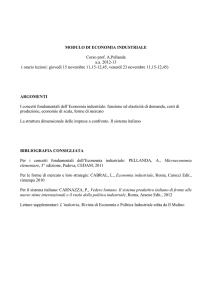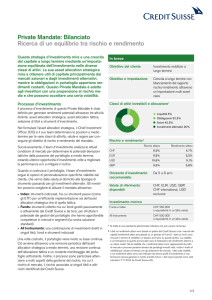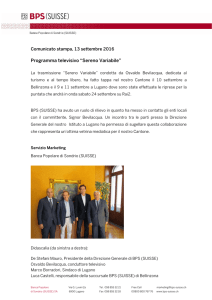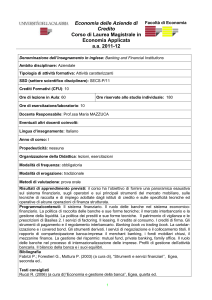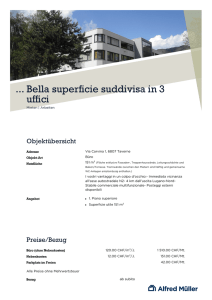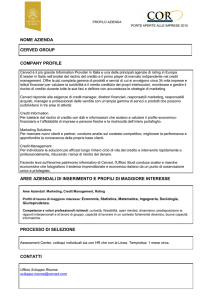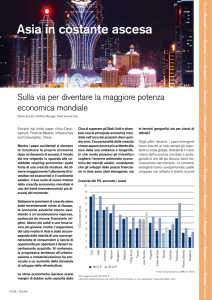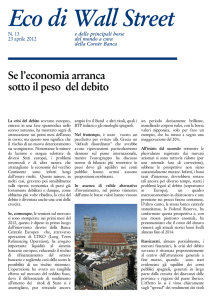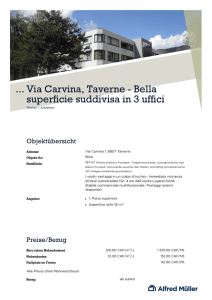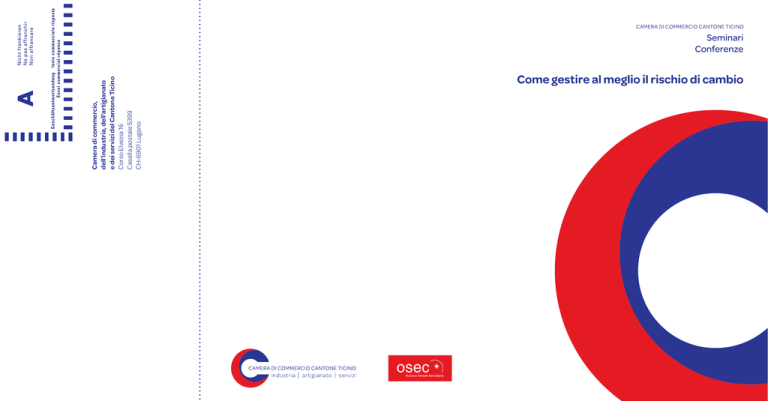
Camera di commercio,
dell’industria, dell’artigianato
e dei servizi del Cantone Ticino
Corso Elvezia 16
Casella postale 5399
CH-6901 Lugano
Seminari
Conferenze
Come gestire al meglio il rischio di cambio
Come gestire al meglio il rischio di cambio
Lunedì 29 novembre 2010, dalle ore 16.30 alle ore 17.45
(networking apero 17.45-18.30)
presso la Camera di commercio, dell’industria,
dell’artigianato e dei servizi del Cantone Ticino (Cc-Ti)
(6° piano, sala dott. Papa)
In collaborazione con:
Seminari
Conferenze
Come gestire al meglio il rischio di cambio
Lunedì 29 novembre 2010, dalle ore 16.30 alle ore 17.45
(networking apero 17.45-18.30)
Introduzione
Programma
Il rischio di cambio è direttamente correlato alla volatilità dei rapporti di cambio tra le varie
divise estere. In quest’ottica, a seconda delle variazioni determinate dal mercato, chi è attivo
nel commercio con l’estero può trovarsi nella situazione di subire perdite o di beneficiare di
guadagni. Infatti, queste variazioni hanno degli effetti diretti sull’operatività delle aziende visto
che gli acquisti ex-ante e le vendite ex-post intaccano chiaramente il margine di profitto sul
prodotto.
A tal proposito, è più che lecito chiedersi in che modo sia possibile minimizzare gli effetti
non desiderati attraverso una gestione attiva ed efficace della problematica, impostando gli
atteggiamenti giusti ed utilizzando gli strumenti finanziari di copertura più adatti.
16.30
Saluto di benvenuto
Marco Passalia, Vice Direttore, Cc-Ti
presso la Camera di commercio, dell’industria, dell’artigianato
e dei servizi del Cantone Ticino (Cc-Ti)
(6° piano, sala dott. Papa)
16.40
Intervento sul tema «Come gestire al meglio il rischio di cambio»
Luca Pellanda e Stefano Putelli, Credit Suisse, FX SALES Private and Business Banking Switzerland
Nome...............................................................................................................
Destinatari
La manifestazione è aperta a tutti gli interessati. Entrata libera.
Relatori
Marco Passalia, Vice Direttore, Cc-Ti
Luca Pellanda, Private and Business Banking Switzerland, Credit Suisse
Stefano Putelli, Private and Business Banking Switzerland, Credit Suisse
Contenuti dell’intervento:
• la guerra dei cambi in atto nel mondo
• il cambio: rischio o opportunità?
• misurazione e controllo del rischio valutario in azienda
• gli strumenti di copertura di ultima generazione
17.45
Networking apero
Cognome........................................................................................................
Funzione.........................................................................................................
Azienda...........................................................................................................
Via....................................................................................................................
Altre informazioni
CAP/Luogo.....................................................................................................
Per iscrizioni prego rivolgersi entro lunedì 22 novembre 2010,
alla Cc-Ti, Signora Veljkovic, tel. 091911 51 11, fax 091 911 51 12,
[email protected], www.cc-ti.ch
Telefono.........................................................................................................................
E-mail.............................................................................................................................
Data.................................................................................................................
Invia
Firma...............................................................................................................................
La manifestazione è aperta a tutti gli interessati. Entrata libera.
Per iscrizioni prego rivolgersi entro lunedì 22 novembre 2010,
alla Cc-Ti, Signora Veljkovic, tel. 091 911 51 11, fax 091 911 51 12,
e-mail [email protected].
Come gestire al meglio il rischio
di cambio
Lugano, 29 novembre 2010
produced by: Luca Pellanda & Stefano Putelli
Agenda
la guerra dei cambi in atto nel mondo
il cambio: rischio o opportunità
- cosa è il rischio di cambio?
misurazione e controllo del rischio valutario in azienda
gli strumenti di copertura di ultima generazione
- strumenti tradizionali
- Risk reversal
- Knock into Forward
- Ratio knock out Forward
Produced by: Luca Pellanda & Stefano Putelli, IHFO 6
FX SALES Private and Business Banking Switzerland
Date: November, 2010 Page 2
La guerra dei cambi in atto nel mondo
Cos'è?
Questa frase è stata usata la prima volta dal ministro delle finanze brasiliano Guido
Mantega all'inizio di ottobre:
"the world is in an international currency war as governements manipulate their
currencies to improve their export competitiveness".
Questa dichiarazione è stata rilasciata prima della decisione della Federal Reserve di
acquistare ulteriori Treasury americani ed introdurre il "Quantitative Easing 2“.
Aumentando la liquidità in USD che viene veicolata in altri mercati, in particolare nei
mercati emergenti, si crea una pressione al rialzo di queste valute che alleggeriscono la
politica monetaria globale: monete più forti, diminuiscono l'inflazione importata e riducono
la necessità mettere in atto una politica monetaria più restrittiva.
Il rischio è quello che forti afflussi di capitale, soprattutto se investiti a corto termine, ad un
determinato momento possano defluire rapidamente, provocando un aumento della
volatilità delle valute con ripercussioni sull'economia.
Noi non abbiamo l'impressione che le valute stiano reagendo come se ci fosse una guerra
dei cambi, secondo noi oscillano semplicemente a dipendenza del cross-bording dei flussi
di capitale ed alle politiche monetarie divergenti dei paesi sviluppati ed emergenti.
Produced by: Luca Pellanda & Stefano Putelli, IHFO 6
FX SALES Private and Business Banking Switzerland
Date: November, 2010 Page 3
La guerra dei cambi in atto nel mondo
Tra paesi sviluppati e EM e tra EM internamente
L'America sta allentando la politica monetaria e l'effetto dovrebbe essere quello di
indebolire l'USD. Parallelamente i Paesi dei mercati emergenti sono confrontati con un
aumento dell'inflazione (gli alimentari ad esempio) e sono obbligati ad adottare una
politica monetaria più aspra
Conseguenze:
- Le valute dei Paesi dove la politica monetaria deve essere inasprita a causa
dell'aumento dell'inflazione tenderanno a sovra performare rispetto al loro "fair value"
(es.: AUD, NZD, CAD)
- Le Banche Centrali di alcuni Paesi dei mercati emergenti (specialmente in Asia)
intervengono sui mercati valutari al fine di ridurre la volatilità e rallentare l'aprezzamento.
Ciò dovrebbe portare un'inflazione dei prezzi degli assets in questi Paesi o
all'introduzione
di misure amministrative come tasse alla fonte o incentivi per l'esportazione di capitali.
Queste valute tenderanno a rimanere sottovalutate prolungando il processo di
allineamento
- Altri paesi emergenti hanno affidato alle forze del libero mercato i movimenti delle
proprie valute (es.:BRL) con una conseguente ed ulteriore sopravalutazione della propria
divisa
Produced by: Luca Pellanda & Stefano Putelli, IHFO 6
FX SALES Private and Business Banking Switzerland
Date: November, 2010 Page 4
Fair Value (modello CS) – Deviation in % vs USD
Deviation in %
50
Overvaluation vs. USD
40
30
20
10
0
-10
-20
-30
-40
Undervaluation vs. USD
CZK
NZD
AUD
NOK
HUF
ZAR
PLN
CHF
CAD
EUR
JPY
GBP
MXN
SEK
THB
SGD
TWD
KRW
CNY
-50
23-Nov-10
Last data point: 24.11.2010
Produced by: Luca Pellanda & Stefano Putelli, IHFO 6
FX SALES Private and Business Banking Switzerland
Date: November, 2010 Page 5
Global FX Reserves
Global FX reserves have continued to increase, especially in Asia.
Index: 1.1.95=100
4'800
4'400
4'000
3'600
3'200
2'800
2'400
2'000
1'600
1'200
800
400
0
1995
FX Reserves (in USD)
1997
Japan
1999
China
2001
Korea
2003
Asia
2005
2007
2009
(ex J,Ch,K)
Source: Bloomberg, Credit Suisse / IDC
Produced by: Luca Pellanda & Stefano Putelli, IHFO 6
FX SALES Private and Business Banking Switzerland
Date: November, 2010 Page 6
Il cambio: rischio o opportunità?
Cosa è il rischio di cambio ?
-Il rischio che un eventuale movimento sfavorevole di una o più valute
penalizzi in modo compromettente gli utili, il cash flow o l'asset value.
"Gli utili per il periodo in questione sono stati influenzati negativamente dalle
esposizioni in valuta estera. Le perdite subite ammontano a usd. 1.5 mio,
pertanto l'utile per il secondo trimestre 2003 è pari a usd. 1.2 mio."
Nu Skin Enterprises, 2004
"Abbiamo avuto tre situazioni che hanno influenzato negativamente il nostro
risultato del I trimestre......Il terzo è stato l'apprezzamento del dollaro nei
confronti dell'euro che ha causato forti perdite sulla parte di contratti per i quali
non erano state fatte le coperture."
MTS System
"La Uroplasty nel II trimestre fiscale annuncia un aumento delle vendite pari al
22% rispetto allo stesso periodo dell'anno precedente. Tuttavia le perdite
sono più che raddoppiate a causa di forti perdite sui cambi ed investimenti
nella ricerca e sviluppo."
Uroplasty, 2002
Produced by: Luca Pellanda & Stefano Putelli, IHFO 6
FX SALES Private and Business Banking Switzerland
Date: November, 2010 Page 7
Previsioni dei maggiori Istituti Finanziari a livello globale
Parità
Spot Nov10
EUR/USD
1.3500
USD/CHF
0.9890
EUR/CHF
1.3350
3 mesi
12 mesi
high
1.4600
1.5500
low
media
1.2500
1.4000
1.1500
1.3300
high
1.0760
1.2100
low
media
0.9000
0.9600
0.8600
1.0160
high
1.4220
1.5890
low
1.3020
1.2400
media
1.3560
1.4350
Produced by: Luca Pellanda & Stefano Putelli, IHFO 6
FX SALES Private and Business Banking Switzerland
Date: November, 2010 Page 8
Misurazione e controllo del rischio valutario in azienda
Gestire al meglio il rischio valutario in 5 punti
1. Definizione del rischio
-definire il tipo di rischio valutario da gestire
2. Quantificare il rischio
-creare il modello al fine di misurare l'esposizione valutaria da
gestire
3. Valutare l'entità dell'esposizione
-calcolo e valutazione dell'esposizione
4. Strategie di copertura
-determinare in che misura e quali esposizioni si vogliono coprire
5. Eseguire la copertura
-effettuare la copertura per il tramite di operazioni plain vanilla o
altri prodotti
Produced by: Luca Pellanda & Stefano Putelli, IHFO 6
FX SALES Private and Business Banking Switzerland
Date: November, 2010 Page 9
Misurazione e controllo del rischio valutario in azienda
1. Definizione del rischio
Economic
Exposure
Transaction
Exposure
Currency
Risk
Forecasted
Exposure
Translation
Exposure
Produced by: Luca Pellanda & Stefano Putelli, IHFO 6
FX SALES Private and Business Banking Switzerland
Date: November, 2010 Page 10
Misurazione e controllo del rischio valutario in azienda
1. Definizione del rischio (risultato di un sondaggio)
Quasi tutte le aziende danno alta priorità alle coperture dei contratti già firmati
Molte aziende considerano le esposizioni previste, ma faticano a gestire un
adeguato programma di copertura del rischio valutario
Diverse aziende tengono conto del rischio valutario del loro bilancio e conto
economico
100%
80%
60%
40%
20%
0%
High
Medium
Low
Transaction Forecasted Translation
Economic
Produced by: Luca Pellanda & Stefano Putelli, IHFO 6
FX SALES Private and Business Banking Switzerland
Date: November, 2010 Page 11
Misurazione e controllo del rischio valutario in azienda
1. Definizione del rischio
Rischio Forex nei confronti dei diversi Paesi controparte
Spazio commerciale
- produzione in CH (costi in chf)
- vendita all'estero (ricavi in eur, usd, jpy, ecc.)
Rischio di cambio in caso di indebolimento delle valute in questione nei
confronti del chf
Esposizione valutaria del saldo del conto economico
Esposizione al netto degli investimenti
Produced by: Luca Pellanda & Stefano Putelli, IHFO 6
FX SALES Private and Business Banking Switzerland
Date: November, 2010 Page 12
Misurazione e controllo del rischio valutario in azienda
2. Misurazione dell'esposizione
Metodologia di
misurazione
Tipo di
Esposizione
Come si misura
Risultato da
sondaggio
Impegni sottoscritti
Transaction
Assets e passivi
Viene effettuato dalla
in valuta estera
Translation
contabilizzati
> parte delle aziende
Pagamenti/incassi
Forecasted
Impegni valutari
Viene effettuato dalla
stimati
> parte delle aziende
Inv. in valuta estera
Di regola non
per progetti futuri
praticato
previsti
Investimenti
Translation
previsti
Averi a rischio
Translation
Valutazione ultime
Di regola non
Entrate a rischio
Transaction
chiusure contabili
praticato
Recessione
Economic
Analisi correlazione
Di regola non
Costi/Ricavi e
praticato
oscillazione valute
Produced by: Luca Pellanda & Stefano Putelli, IHFO 6
FX SALES Private and Business Banking Switzerland
Date: November, 2010 Page 13
Misurazione e controllo del rischio valutario in azienda
3. Valutare l'entità dell'esposizione
Treasury WS
Hedge Trading
Applicazione
gest.posizioni
Contabilità
Pianificazione
delle risorse
Tabella Excel
E-mail
Web
File upload
Applicaz.
Telefono
Esposizione
Hedge Admin.
Valutaria
Executive
Dashboard
Netting
Produced by: Luca Pellanda & Stefano Putelli, IHFO 6
FX SALES Private and Business Banking Switzerland
Date: November, 2010 Page 14
Misurazione e controllo del rischio valutario in azienda
3. Valutare l'entità dell'esposizione
Costi/Ricavi
- effettivi al netting in valuta estera da convertire
Previsioni annuali
- da valutare l'esposizione per ogni trimestre
Monitorare l'andamento attuale rispetto alle previsioni
Altre opportunità
- gestire le attività di copertura
- adattare le coperture alle modifiche dell'andamento commerciale
Produced by: Luca Pellanda & Stefano Putelli, IHFO 6
FX SALES Private and Business Banking Switzerland
Date: November, 2010 Page 15
Misurazione e controllo del rischio valutario in azienda
4. Strategie di copertura
Strategia
Caratteristiche
Rischio
Currency Forwards
Operazione a termine
Basso
Currency Options
Copertura ad un prezzo svantaggioso,
non vincolante
Functional Currency Compenso razionale dei debiti/crediti
Debt Issuance
"Exotics"
Derivatives
nella stessa valuta
Basso/Medio
Medio
Coperture su misura in base alle
previsioni di mercato, la propensione al
Medio/Alto
rischio ed alle necessità aziendali
Functional Currency Trasferire il rischio cambio su clienti e
Invoicing
fornitori
Revenue/Expense
Ricerca di concentrare i costi nella
Matching
stessa valuta di fatturazione
Medio/Alto
Medio/Alto
Produced by: Luca Pellanda & Stefano Putelli, IHFO 6
FX SALES Private and Business Banking Switzerland
Date: November, 2010 Page 16
Misurazione e controllo del rischio valutario in azienda
5. Eseguire la copertura
Conclusione delle
Op. di copertura
Riconoscere e
Decidere la
Proposte
Quantificare
Politica di
Operazioni di
l'Esposizione
Copertura
Copertura
-Controllo efficienza
della copertura
-Rapporto finanziario
-Rivalutazione dell'
Esposizione regolare
Confermare le
Operazioni
concluse
Contabilizzare le
Operazioni
Produced by: Luca Pellanda & Stefano Putelli, IHFO 6
FX SALES Private and Business Banking Switzerland
Date: November, 2010 Page 17
Misurazione e controllo del rischio valutario in azienda
In sintesi
Definizione del Rischio
- concetto soggettivo a dipendenza della propensione al rischio dell'azienda
Raccogliere i dati e misurare l' Esposizione
- analizzare il bilancio aziendale e leggerne l'esposizione (ricavi, acquisti,
ammortamenti, investimenti)
Prevedere il Worst Case
- indipendentemente dalle convinzioni personali è utile determinare con
anticipo lo scenario più sfavorevole ed agire di conseguenza
Determinare la strategia di copertura idonea
- una volta definita la propria propensione al rischio e valutati gli impatti sul
risultato aziendale, si determina la strategia più appropriata
Produced by: Luca Pellanda & Stefano Putelli, IHFO 6
FX SALES Private and Business Banking Switzerland
Date: November, 2010 Page 18
Hedging "tradizionali"
cosa conosciamo ….
… operazioni spot
… operazioni a termine
… opzioni plain vanilla
Quali altre possibilità esistono ?
Produced by: Luca Pellanda & Stefano Putelli, IHFO 6
FX SALES Private and Business Banking Switzerland
Date: November, 2010 Page 19
Strumenti di copertura
Risk Reversal
Come responsabile delle finanze state pianificando il vostro fabbisogno di EUR/CHF
per il prossimo anno
Questi i dati a vostra disposizione:
Cambio di budget EUR/CHF
1.3800
Uscite previste
EUR 1.2 Mio
Data di scadenza
31.12.2011
EURCHF
P&L
CHF
Posizione senza
protezione
+100'000
1.4000
Cambio
di budget
1.3800
1.3600
1.3400
1.3200
1.30
1.35
1.40
1.45
1.3000
EURCHF
1.2800
1.2600
1.2400
-100'000
01.01
31.03
30.06
30.07
31.12
Produced by: Luca Pellanda & Stefano Putelli, IHFO 6
FX SALES Private and Business Banking Switzerland
Date: November, 2010 Page 20
Strumenti di copertura
Risk Reversal
Una possibilità è quella di acquistare un'opzione Call Strike 1.38 finanziandola
con la vendita di un'opzione Put.
Questa è la strategia Risk Reversal
Valuta
31.12.11
Acquisto Call (prezzo max)
1.3700
Vendita Put (prezzo minimo)
1.2700
Premio
Spot di riferimento
Diritto
Obbligo
Costo zero
1.3300
Il RR permette una copertura a costo zero
Al contrario del forward il RR offre un'opportunità di acquisto ad un livello
più conveniente
Per il tramite della strategia RR si fissano un top ed un bottom
Produced by: Luca Pellanda & Stefano Putelli, IHFO 6
FX SALES Private and Business Banking Switzerland
Date: November, 2010 Page 21
Valeur 31.12
Vente Cal /
1.4 10 Obligation
Taux maximum
Achat put /
1.40 0 Droit
Taux minimum
Prime en CHF Zéro-coût
Strumenti di copertura
Risk Reversal
Se il cambio si trovasse tra i due Strikes (scenario verde): il
cliente potrà acquistare euro al prezzo di mercato il 31.12.11
EURCHF
1.4000
1.3800
Strike
Call
Scenario Blu
1.40
1.37
1.3400
Scenario Verde
1.32
1.32
1.3200
Scenario Rosso
1.24
1.27
1.3600
1.3000
1.2800
Strike
Put
1.2600
Prezzo di mercato Prezzo di acquisto
1.2400
01.01
31.03
30.06
30.07
31.12
Produced by: Luca Pellanda & Stefano Putelli, IHFO 6
FX SALES Private and Business Banking Switzerland
Date: November, 2010 Page 22
Strumenti di copertura
Risk Reversal
Costo acquisto call 1.3700 + Utile vendita Put 1.2700 = zero
P&L
P&L
Short Put 1.27
EURCHF
1.2700
1.27
1.37
EURCHF
P&L
1.3700
Long call 1.37
EURCHF
Produced by: Luca Pellanda & Stefano Putelli, IHFO 6
FX SALES Private and Business Banking Switzerland
Date: November, 2010 Page 23
Strumenti di copertura
Risk Reversal
Vantaggi
° Copertura del rischio di cambio
al prezzo stabilito
° Possibilità di acquistare ad un
prezzo migliore in caso di
evoluzione favorevole dello
spot EUR/CHF
Svantaggi
°
Potenziale di utile limitato
°
Obbligo d'acquisto ad un
prezzo meno vantaggioso rispetto
al prezzo di mercato se il corso
alla scadenza si trova al di sotto
di 1.2700
° Nessun premio a carico del
cliente
Produced by: Luca Pellanda & Stefano Putelli, IHFO 6
FX SALES Private and Business Banking Switzerland
Date: November, 2010 Page 24
Strumenti di copertura
Knock into Forward
Come responsabile delle finanze state pianificando il vostro fabbisogno di EUR/CHF
per il prossimo anno
Questi i dati a vostra disposizione:
Cambio di budget EUR/CHF
1.3800
Uscite previste
EUR 1.2 Mio
Data di scadenza
31.12.2011
EURCHF
P&L
CHF
Posizione senza
protezione
1.4000
Cambio
di budget
1.3800
+100'000
1.3600
1.3400
1.3200
1.30
1.35
1.40
1.45
1.3000
EURCHF
1.2800
1.2600
1.2400
-100'000
01.01
31.03
30.06
30.07
31.12
Produced by: Luca Pellanda & Stefano Putelli, IHFO 6
FX SALES Private and Business Banking Switzerland
Date: November, 2010 Page 25
Strumenti di copertura
Knock into Forward
Un'altra possibilità: acquistare un'Opzione Call Strike 1.3500 finanziandola con la vendita
di un'Opzione Put esotica Strike 1.3500 (un put con Knock-in a 1.1400)
Valuta
31.12.11
Acquisto Call (prezzo max)
1.3500
Vendita Put con Knock-in
1.3500
Knock-in
Premio
Spot di riferimento
1.1400
Diritto
Obbligo
Costo zero
1.3300
La vendita del Put non contempla nessun obbligo fino al raggiungimento del livello
Knock-in che, se toccato, trasforma il prodotto in un acquisto forward sintetico
Adatto se si prevede una flessione contenuta della partià EUR/CHF
Produced by: Luca Pellanda & Stefano Putelli, IHFO 6
FX SALES Private and Business Banking Switzerland
Date: November, 2010 Page 26
Strumenti di copertura
Knock into Forward
Scenari possibili alla scadenza:
FX Rate
Budget rate
Conversion Rate
acquisto a 1.3500
acquisto a 1.2000
acquisto a 1.3500
KI Level
Trade Date
Expiry
Time
Source: Credit Suisse
Produced by: Luca Pellanda & Stefano Putelli, IHFO 6
FX SALES Private and Business Banking Switzerland
Date: November, 2010 Page 27
Strumenti di copertura
Knock into Forward
P&L
RKI
1.1400
P&L
Short Put 1.35
RKI 1.1400
1.3500
EURCHF
RKI
1.1400
1.30
1.20
1.40
EURCHF
P&L
Long call + Short Put RKI
1.3500
EURCHF
Long call 1.35
Produced by: Luca Pellanda & Stefano Putelli, IHFO 6
FX SALES Private and Business Banking Switzerland
Date: November, 2010 Page 28
Strumenti di copertura
Knock into Forward
Il KiF permette in questo caso di coprire l'esposizione con profitto rispetto al
Budget, beneficiando di un indebolimento parziale della parità EUR/CHF
Corso di
mercato
Budget
Cambio finale Acq. Eur 1.2 mio Utile vs Budget
1.3800
Chf. 1'656'000
Scenario Verde
1.4300
1.3500
Chf. 1'620'000
Chf. 36'000
Scenario Blu
1.2000
1.2000
Chf. 1'440'000
Chf. 216'000
Scenario Rosso
1.1200
1.3500
Chf. 1'620'000
Chf. 36'000
Produced by: Luca Pellanda & Stefano Putelli, IHFO 6
FX SALES Private and Business Banking Switzerland
Date: November, 2010 Page 29
Strumenti di copertura
Knock into Forward
Svantaggi
Vantaggi
° Copertura del rischio cambio
ad un livello prefissato
° Possibilità di generare degli
utili se non venisse toccato
il livello Knock-in
° Nessun premio a carico
°
Limita il potenziale di utile
rispetto ad un'opzione vanilla
° Nel caso venisse toccato
il livello Knock-in il prezzo d'
esercizio potrebbe essere
svantaggioso rispetto
al mercato
del cliente
Produced by: Luca Pellanda & Stefano Putelli, IHFO 6
FX SALES Private and Business Banking Switzerland
Date: November, 2010 Page 30
RKOF - Introduzione
Il Ratio Knock-Out Forward (RKOF) è un’alternativa alla tradizionale operazione a
termine, che da la possibilità al contraente di acquistare o vendere una determinata
valuta contro un‘altra ad un prezzo più conveniente rispetto all’operazione a termine
.
Ratio Knock-Out Forward-Esempio: Acq. EUR/CHF
Knock-Out
Barrier
Il RKOF da la possibilità al cliente di acquistare
Profit/
Loss
regolarmente EUR contro CHF ad un cambio inferiore
(strike) rispetto al cambio a termine, fino a quando,
durante il periodo di osservazione, la barriera Knock-out
definita precedentemente non viene superata o toccata
EUR/CHF
exchange rate
Con questa strategia, il cliente ha la possibilità di
migliorare il cambio di copertura rispetto al prezzo a
termine a condizione che la parità EUR/CHF abbia dei
Knock-out never reached or
breached
movimenti laterali o si apprezzi moderatamente
Leverage modulabile
Produced by: Luca Pellanda & Stefano Putelli, IHFO 6
FX SALES Private and Business Banking Switzerland
Date: November, 2010 Page 31
RKOF – Acquisto EUR/CHF
Come funziona
Ad ogni “fixing date” dove la parità EUR/CHF quota al di sopra dello Strike, il
contraente RKOF acquista EUR, per il nominale sottoscritto, al prezzo Strike
Se invece ad ogni “fixing date” dove la parità EUR/CHF quota il o al di sotto del
prezzo Strike il contraente è obbligato ad acquistare EUR, in base alla leva
stabilita nel contratto, al prezzo Strike
Se la barriera Knock-out viene raggiunta o superata, da quel momento diritti
e/o obblighi vengono a cadere (KO)
Produced by: Luca Pellanda & Stefano Putelli, IHFO 6
FX SALES Private and Business Banking Switzerland
Date: November, 2010 Page 32
RKOF – Esempio
Necessità
Strike
Knock-Out Barrier (KO)
Durata
Importo
Corsi di riferimento
Periodo di Osservazione
Buying EUR/CHF
1.2800
1.4750
12 months (with 12 monthly fixings, first 31.01.11)
EUR 100.000 vs. EUR 200.000 per montly fixing
Spot 1.3300, average fwd 1.3245
Trade date until final fixing (continuous)
RKOF
Before KO Event
After KO Event
Fino a quando non viene toccato il livello di knock-out il contraente del RKOF
acquista mensilmente EUR contro CHF a 1.2800 (Strike)
- se il giorno della scadenza EUR/CHF è quotato al di sopra dello Strike,
il contraente acquista EUR 100’000
- mentre, se EUR/CHF è quotato allo stesso prezzo o sotto lo Strike,
il contraente acquista EUR 200’000
Se venisse toccato il livello di knock-out il RKOF scadrebbe e da quel
momento non verrebbero più acquistati EUR
Condizioni indicative del 26 novembre 2010
Produced by: Luca Pellanda & Stefano Putelli, IHFO 6
FX SALES Private and Business Banking Switzerland
Date: November, 2010 Page 33
RKOF – Esempio
Month
Strike
Fixing
Spot Rate
Position of RKOF holder
P/L
1
1.2800
1.3275
Buy EUR 100‘000 @ 1.2800
+CHF 4'750
2
1.2800
1.2380
Buy EUR 200‘000 @ 1.2800
-CHF 8'400
3
1.2800
1.2800
Buy EUR 200‘000 @ 1.2800
0
4
1.2800
1.2950
Buy EUR 100‘000 @ 1.2800
+CHF 1'500
5
1.2800
1.3400
Buy EUR 100‘000 @ 1.2800
+CHF 6'000
Produced by: Luca Pellanda & Stefano Putelli, IHFO 6
FX SALES Private and Business Banking Switzerland
Date: November, 2010 Page 34
RKOF In sintesi
Vantaggi
Svantaggi/Rischi
Rischio Knock-out (KO): se lo Spot toccasse
L’RKOF ha uno Strike molto più attrattivo
o superasse anche una sola volta questo
del rispettivo prezzo a termine al momento
livello durante la durata del contratto, i diritti
della conclusione
e gli obblighi sottoscritti verrebbero a cadere
L’RKOF non è un Bond o un Investimento
legato ad un deposito. Il contraente non
immendiatamente
Rischio Leva: a causa della leva (1x2) il
deve anticipare l’intero importo del RKOF.
cliente del RKOF potrebbe essere obbligato
Trattandosi di una copertura a costo zero il
ad acquistare in leva ad un cambio in quel
cliente non viene addebitato di nessuna
spesa
momento sfavorevole
Se ad ogni scadenza il prezzo Spot fosse
inferiore allo Strike, l’acquisto (in leva 2:0),
se pareggiato immediatamente sul mercato
causerebbe perdita netta. Se non pareggiato
comporterebbe
comunque
una
perdita
provvisoria mark-to-market
Produced by: Luca Pellanda & Stefano Putelli, IHFO 6
FX SALES Private and Business Banking Switzerland
Date: November, 2010 Page 35
Global Disclaimer / Important Information
References in this report to Credit Suisse include subsidiaries and affiliates. For more information on our structure, please use the
following link:
http://www.credit-suisse.com/who_we_are/en/
The information and opinions expressed in this report were produced by the Global Research department of the Private Banking
division at Credit Suisse as of the date of writing and are subject to change without notice. Views expressed in respect of a
particular stock in this report may be different from, or inconsistent with, the observations and views of the Credit Suisse Research
department of Investment Banking division due to the differences in evaluation criteria. The report is published solely for information
purposes and does not constitute an offer or an invitation by, or on behalf of, Credit Suisse to buy or sell any securities or related
financial instruments or to participate in any particular trading strategy in any jurisdiction. It has been prepared without taking
account of the objectives, financial situation or needs of any particular investor. Although the information has been obtained from
and is based upon sources that Credit Suisse believes to be reliable, no representation is made that the information is accurate or
complete. Credit Suisse does not accept liability for any loss arising from the use of this report. The price and value of investments
mentioned and any income that might accrue may fluctuate and may rise or fall. Nothing in this report constitutes investment, legal,
accounting or tax advice, or a representation that any investment or strategy is suitable or appropriate to individual circumstances,
or otherwise constitutes a personal recommendation to any specific investor. Any reference to past performance is not necessarily
indicative of future results. Foreign currency rates of exchange may adversely affect the value, price or income of any products
mentioned in this document. Alternative investments, derivative or structured products are complex instruments, typically involve a
high degree of risk and are intended for sale only to investors who are capable of understanding and assuming all the risks
involved. Investments in emerging markets are speculative and considerably more volatile than investments in established markets.
Risks include but are not necessarily limited to: political risks; economic risks; credit risks; currency risks; and market risks. Before
entering into any transaction, investors should consider the suitability of the transaction to individual circumstances and objectives.
In jurisdictions where Credit Suisse is not already registered or licensed to trade in securities, transactions will only be effected in
accordance with applicable securities legislation, which will vary from jurisdiction to jurisdiction and may require that the trade be
made in accordance with applicable exemptions from registration or licensing requirements. Credit Suisse recommends that
investors independently assess, with a professional financial advisor, the specific financial risks as well as legal, regulatory, credit,
tax and accounting consequences. A Credit Suisse company may, to the extent permitted by law, participate or invest in other
financing transactions with the issuer of the securities referred to herein, perform services or solicit business from such issuers,
and/or have a position or effect transactions in the securities or options thereof.
Produced by: Luca Pellanda & Stefano Putelli, IHFO 6
FX SALES Private and Business Banking Switzerland
Date: November, 2010 Page 36
Global Disclaimer / Important Information
For further information, including disclosures with respect to any other issuers, please refer to the Credit Suisse Global Research Disclosure site at:
https://www.credit-suisse.com/research/disclaimer
Distribution of research reports
Except as otherwise specified herein, this report is distributed by Credit Suisse AG, a Swiss bank, authorized and regulated by the Swiss Financial Market Supervisory Authority. Australia:
This report is distributed in Australia by Credit Suisse AG, Sydney Branch (CSSB) (ABN 17 061 700 712 AFSL 226896) only to "Wholesale" clients as defined by s761G of the Corporations
Act 2001. CSSB does not guarantee the performance of, nor make any assurances with respect to the performance of any financial product referred herein. Bahamas: This report was
prepared by Credit Suisse AG, the Swiss bank, and is distributed on behalf of Credit Suisse AG, Nassau Branch, a branch of the Swiss bank, registered as a broker-dealer by the
Securities Commission of the Bahamas. Bahrain: This report is distributed by Credit Suisse AG, Bahrain Branch, authorized and regulated by the Central Bank of Bahrain (CBB) as an
Investment Firm Category 2. Dubai: This information is distributed by Credit Suisse AG, Dubai Branch, duly licensed and regulated by the Dubai Financial Services Authority (DFSA).
Related financial products or services are only available to wholesale customers with liquid assets of over USD 1 million who have sufficient financial experience and understanding to
participate in financial markets in a wholesale jurisdiction and satisfy the regulatory criteria to be a client. France: This report is distributed by Credit Suisse (France), authorized by the
Comité des Etablissements de Crédit et des Entreprises d’Investissements (CECEI) as an investment service provider. Credit Suisse (France) is supervised and regulated by the
Commission Bancaire and the Autorité des Marchés Financiers. Germany: Credit Suisse (Deutschland) AG, authorized and regulated by the Bundesanstalt fuer
Finanzdienstleistungsaufsicht (BaFin), disseminates research to its clients that has been prepared by one of its affiliates. Gibraltar: This report is distributed by Credit Suisse (Gibraltar)
Limited. Credit Suisse (Gibraltar) Limited is an independent legal entity wholly owned by Credit Suisse and is regulated by the Gibraltar Financial Services Commission. Guernsey: This
report is distributed by Credit Suisse (Guernsey) Limited, an independent legal entity registered in Guernsey under under 15197, with its registered address at Helvetia Court, Les
Echelons, South Esplanade, St Peter Port, Guernsey. Credit Suisse (Guernsey) Limited is wholly owned by Credit Suisse and is regulated by the Guernsey Financial Services Commission.
Hong Kong: This report is issued in Hong Kong by Credit Suisse AG Hong Kong Branch, an Authorized Institution regulated by the Hong Kong Monetary Authority and a Registered
Institution regulated by the Securities and Futures Ordinance (Chapter 571 of the Laws of Hong Kong). India: This report is distributed by Credit Suisse Securities (India) Private Limited
("Credit Suisse India"), regulated by the Securities and Exchange Board of India (SEBI). Italy: This report is distributed in Italy by Credit Suisse (Italy) S.p.A., a bank incorporated and
registered under Italian law subject to the supervision and control of Banca d’Italia and CONSOB. Luxembourg: This report is distributed by Credit Suisse (Luxembourg) S.A., a
Luxembourg bank, authorized and regulated by the Commission de Surveillance du Secteur Financier (CSSF). Mexico: The information contained herein does not constitute a public offer
of securities as defined in the Mexican Securities Law. This report will not be advertised in any mass media in Mexico. This report does not contain any advertisement regarding
intermediation or providing of banking or investment advisory services in Mexico or to Mexican citizens. Qatar: This information has been distributed by Credit Suisse Financial Services
(Qatar) L.L.C, which has been authorized and is regulated by the Qatar Financial Centre Regulatory Authority (QFCRA) under QFC No. 00005. All related financial products or services will
only be available to Business Customers or Market Counterparties (as defined by the Qatar Financial Centre Regulatory Authority (QFCRA)), including individuals, who have opted to be
classified as a Business Customer, with liquid assets in excess of USD 1 million, and who have sufficient financial knowledge, experience and understanding to participate in such products
and/or services. Russia: The research contained in this report does not constitute any sort of advertisement or promotion for specific securities, or related financial instruments. This
research report does not represent a valuation in the meaning of the Federal Law On Valuation Activities in the Russian Federation and is produced using Credit Suisse valuation models
and methodology. Singapore: Distributed by Credit Suisse AG, Singapore Branch, regulated by the Monetary Authority of Singapore. Spain: This report is distributed in Spain by Credit
Suisse AG, Sucursal en España, authorized under number 1460 in the Register by the Banco de España. Thailand: This report is distributed by Credit Suisse Securities (Thailand) Limited,
regulated by the Office of the Securities and Exchange Commission, Thailand, with its registered address at 990 Abdulrahim Place Building, 27/F, Rama IV Road, Silom, Bangrak,
Bangkok Tel. 0-2614-6000. United Kingdom: This report is issued by Credit Suisse (UK) Limited and Credit Suisse Securities (Europe) Limited. Credit Suisse Securities (Europe) Limited
and Credit Suisse (UK) Limited, both authorized and regulated by the Financial Services Authority, are associated but independent legal entities within Credit Suisse. The protections made
available by the Financial Services Authority for retail clients do not apply to investments or services provided by a person outside the UK, nor will the Financial Services Compensation
Scheme be available if the issuer of the investment fails to meet its obligations.
UNITED STATES: NEITHER THIS REPORT NOR ANY COPY THEREOF MAY BE SENT, TAKEN INTO OR DISTRIBUTED IN THE UNITED STATES OR TO ANY US PERSON.
Japan: Neither this report nor any copy thereof may be sent, taken or distributed in Japan.
Local law or regulation may restrict the distribution of research reports into certain jurisdictions.
This report may not be reproduced either in whole or in part, without the written permission of Credit Suisse. Copyright © 2010 Credit Suisse Group AG and/or its affiliates. All rights
reserved.
10C018A
Produced by: Luca Pellanda & Stefano Putelli, IHFO 6
FX SALES Private and Business Banking Switzerland
Date: November, 2010 Page 37
Disclaimer – OTC Hedging Solutions
This document is issued by Credit Suisse, solely for information purposes and for the recipient’s sole use. It is not the result
of a financial analysis and therefore not subject to the “Directives on the Independence of Financial Research” (Swiss
Bankers Association). This document does not constitute an offer or an invitation by or on behalf of Credit Suisse to enter
into a OTC transaction with the terms as described herein. The only binding terms of this OTC transaction will be set forth
in the specific OTC contracts and confirmations prepared by Credit Suisse. Credit Suisse does not make any
representation as to the accuracy or completeness of this document and assumes no liability for losses and tax implications
arising from the use hereof.
A Credit Suisse Group company may be involved in other transactions related to any underlying of the above OTC
transaction, which are not disclosed herein.
Derivative transactions may be complex and may involve a high degree of risk. They are intended only for investors who
understand and are capable of assuming all risks involved. Before entering into any OTC transaction, an investor should
determine if this OTC transaction suits its particular circumstances and should independently assess (with its professional
advisers) the specific risks (maximum loss, currency risks, etc.) and the legal, regulatory, credit, tax and accounting
consequences. Credit Suisse makes no representation as to the suitability of this OTC transaction for any particular
investor nor as to the future performance of this OTC transaction. Neither this document nor any copy may be sent, taken
into or distributed in the United States or to any U. S. person or in any other jurisdiction except under circumstances that
will result in compliance with the applicable laws thereof. This document may not be reproduced either in whole or in part,
without the written permission of Credit Suisse
Copyright © 2009 Credit Suisse Group AG and/or its affiliates.
Produced by: Luca Pellanda & Stefano Putelli, IHFO 6
FX SALES Private and Business Banking Switzerland
Date: November, 2010 Page 38

